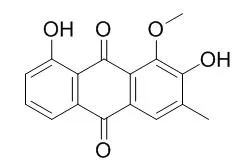| Animal Research: |
| Cell Biochem Biophys. 2014 Dec;70(3):1751-7. | | Obtusifolin treatment improves hyperlipidemia and hyperglycemia: possible mechanism involving oxidative stress.[Pubmed: 25015065] | Clinical research has confirmed the efficacy of several plant extracts in the modulation of oxidative stress associated with hyperlipidemia and hyperglycemia induced by obesity and diabetes. Findings indicate that Obtusifolin has antioxidant properties. The aim of this study was to evaluate the possible protective effects of Obtusifolin against oxidative damage in diabetic hyperlipidemia and hyperglycemia.
METHODS AND RESULTS:
In this study, the rats were divided into the following groups with eight animals in each: control, untreated diabetic, three Obtusifolin (10, 30, and 90 mg/kg/day)-treated diabetic groups. Diabetes was induced by streptozotocin (STZ) in rats. STZ was injected intraperitoneally at a single dose of 60 mg/kg for diabetes induction. Obtusifolin (intraperitoneal injection) was administered 3 days after STZ administration; these injections were continued to the end of the study (4 weeks). At the end of the 4-week period, blood was drawn for biochemical assays. In order to determine the changes of cellular antioxidant defense systems, antioxidant enzymes including glutathione peroxidase (GPx), superoxide dismutase (SOD), and catalase (CAT) activities were measured in serum. Moreover, we also measured serum nitric oxide (NO) and serum malondialdehyde (MDA) levels, markers of lipid peroxidation. STZ-induced diabetes caused an elevation (P < 0.001) of blood glucose, MDA, NO, total lipids, triglycerides and cholesterol, with reduction of GSH level and CAT and SOD activities. The results indicated that the significant elevation in the blood glucose, MDA, NO, total lipids, triglycerides and cholesterol; also the reduction of glutathione level and CAT and SOD activity were ameliorated in the Obtusifolin-treated diabetic groups compared with the untreated groups, in a dose-dependent manner (P < 0.05, P < 0.01, P < 0.001).
CONCLUSIONS:
These results suggest that Obtusifolin has antioxidant properties and improves chemically induced diabetes and its complications by modulation of oxidative stress. | | J Pharmacol Sci. 2009 Oct;111(2):110-6. | | Gluco-obtusifolin and its aglycon, obtusifolin, attenuate scopolamine-induced memory impairment.[Pubmed: 19834282] |
METHODS AND RESULTS:
In the present study, we assessed the effects of gluco-Obtusifolin, isolated from the seeds of Cassia obtusifolia L., and its aglycone, Obtusifolin, on the learning and memory impairments induced by scopolamine using the passive avoidance and the Morris water maze tasks in mice. Gluco-Obtusifolin (1, 2, and 4 mg/kg, p.o.) and Obtusifolin (0.25, 0.5, 1, and 2 mg/kg, p.o.) significantly reversed scopolamine-induced cognitive impairments in the passive avoidance test (P<0.05). Moreover, gluco-Obtusifolin (2 mg/kg, p.o.) and Obtusifolin (0.5 mg/kg, p.o.) improved escape latencies, swimming times in the target quadrant, and crossing numbers in the zone where the platform previously existed in the Morris water maze test. In the acetylcholinesterase assay, gluco-Obtusifolin and Obtusifolin were found to inhibit acetylcholinesterase activity in vitro (IC(50) = 37.2 and 18.5 microM, respectively) and ex vivo.
CONCLUSIONS:
These results suggest that gluco-Obtusifolin and its aglycone may be useful for the treatment of cognitive impairment, and that its beneficial effects are mediated, in part, by the enhancement of cholinergic signaling. |
|






 Cell. 2018 Jan 11;172(1-2):249-261.e12. doi: 10.1016/j.cell.2017.12.019.IF=36.216(2019)
Cell. 2018 Jan 11;172(1-2):249-261.e12. doi: 10.1016/j.cell.2017.12.019.IF=36.216(2019) Cell Metab. 2020 Mar 3;31(3):534-548.e5. doi: 10.1016/j.cmet.2020.01.002.IF=22.415(2019)
Cell Metab. 2020 Mar 3;31(3):534-548.e5. doi: 10.1016/j.cmet.2020.01.002.IF=22.415(2019) Mol Cell. 2017 Nov 16;68(4):673-685.e6. doi: 10.1016/j.molcel.2017.10.022.IF=14.548(2019)
Mol Cell. 2017 Nov 16;68(4):673-685.e6. doi: 10.1016/j.molcel.2017.10.022.IF=14.548(2019)